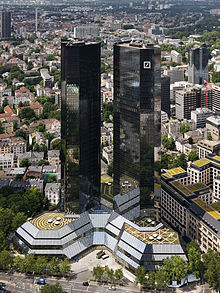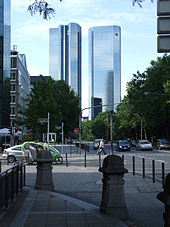- Deutsche Bank Twin Towers
-
Deutsche Bank Twin Towers Deutsche-Bank-Hochhaus 
The Deutsche Bank Twin Towers at banking district of FrankfurtGeneral information Location Frankfurt am Main, Germany Coordinates 50°06′49″N 8°40′05″E / 50.11361°N 8.66806°ECoordinates: 50°06′49″N 8°40′05″E / 50.11361°N 8.66806°E Construction started 1979 Completed 1984 Height Roof 506 ft (154 m) Technical details Floor count West Tower: 40
East Tower: 38Floor area 645,834 sq ft (60,000 m2) Design and construction Architect Walter Hanig, Heinz Scheid, Johannes Schmidt The Deutsche Bank Twin Towers (German: "Deutsche Bank Zwillingstürme" or "Deutsche-Bank-Hochhaus") consists of two skyscrapers that are each 155 meters high. They are also called debit and credit (Soll und Haben), or German bank called Twin Towers I and II. It is the headquarters of Deutsche Bank Group, located in the banking district in Frankfurt, Germany. It is one of the best known buildings in Germany because of its high media coverage.
The Taunusanlage S-Bahn station is located at the foot of the building. The largest man-shaped monolith of the world, created by the Swiss sculptor Max Bill, is located in front of the entrance.
Contents
Architecture
The skyscraper was built from 1979 to 1984 according to designs by Walter Hanig, Heinz Scheid, and Johannes Schmidt. It stands on the Taunusanlage near the Old Opera House, at the beginning of the Mainzer Landstrasse, and the border districts of the West End, downtown and railway station district. The towers were originally planned as a hotel for the American Hyatt Hotel Group. When taken as the towers of the Deutsche Bank, they were already under construction. Immediately outside the main entrance are the entrances to the underground train station Taunusanlage. South and east there is the green area of the city walls, the dramatic views of the buildings provide, to the west joins the axis of the tower at Mainzer Landstrasse (followed by a short distance between the skyscrapers of Trianon, Frankfurter Büro Center and Westendstraße 1). To the north lies the Wilhelminian shaped residential West End, which is protected from further high-rise buildings.
The complex consists of three parts: a four-storey base building and the twin towers. The buildings are complete reinforced concrete structures with superior reflective glass facades.
In contrast to the neighboring high-rise Trianon, built a few years later, the pedestal of the Deutsche Bank skyscraper adapts to the urban environment. It's lower than the neighboring buildings, but spread out over a large base area. From the center of the plant (between the two towers) stretch on an irregular floor plan three components to the east, southwest and northwest. In both the horizontal and the vertical of 45 degrees has Fußbau many angles.
The two towers also have an irregular shape, but in both cases the same floor plan with many 45-degree angles and are symmetric arranged in 13 m distance to the center of the plant around.
The building has become a popular backdrop in print media and television as a symbol of the German economy, which contributed one hand, the distinctive twin-tower configuration, the other the role of Deutsche Bank as a centerpiece of Germany designated AG, close interpenetration big German companies.
Construction
The two towers share a 4660 m² large foundation slab, which is 4 m thick in the middle and tapers towards the edges to 2.5 meters. The panel consists of 16,122 m³ of reinforced concrete. The formation depth is approximately 13 m below ground level.
Renovation
In 2006 it was decided the towers should be rebuilt due to changes in fire regulations. On this occasion, the German bank decided after 22 years of use to start a major upgrade, which began in December 2007 and will take about two and a half years. Not only the fire protection systems will be improved, but also the entire climate, water and lighting technology will be replaced. This will cause energy consumption and CO 2 emissions in the building to be reduced at least 50%. A Neuverglasung (re-glazing) with opening windows will improve the energy balance further. The goal is to certify the building as a green building according to American standard LEED certification with the highest platinum for existing buildings (Existing Buildings), and the German seal of approval DGNB.USGBC erhalten. The towers are the first high-rises to be given this certification by the USGBC. For the interior, the Bank has chosen the Milanese architect Mario Bellini. During the construction work, approximately 2,500 employees will be relocated to three other locations in the relative vicinity of the towers, including the Investment Banking Center near the trade fair.
See also
External links
Categories:- Skyscrapers in Frankfurt
- Skyscrapers in Germany
- Skyscrapers between 150 and 199 meters
- Buildings and structures completed in 1984
- Twin towers
- Bank headquarters
Wikimedia Foundation. 2010.

